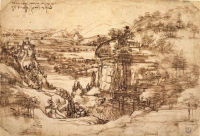
- Enlarge
- Zoom & explore
- © Soprintendenza Speciale Polo Museale Fiorentino
Landscape drawing 1473
The inscription on this drawing, written in Leonardo’s characteristic mirror-writing reads “(feast) of Saint Mary of the Snow/ -day of August 5th, 1473” and indicates that this is Leonardo’s earliest surviving drawing, drawn when the artist was just 21 years old.
Attempts to identify the exact location on which Leonardo based this study have proved unsuccessful, indicating that this is likely to be an imaginatively re-created vision of the Arno valley in a bird’s eye view, as envisaged from a typical hillside on Montalbano near Vinci, Leonardo’s home town or elsewhere in Tuscany.
The drawing is a testament to Leonardo’s early study of nature and to his ability to redefine forms according to his own creative will. Feint traces of lines beneath the pen and ink may indicate that Leonardo first sketched the main features of the landscape, perhaps in situ, and then later, in his studio, re-inforced the lines, making subtle changes and additions.
The drawing also expresses a new sensitivity towards light and space on the part of the artist, the effects of which are perfectly captured in a mesh of curved and parallel dynamic, hatched lines, rapidly applied with the pen and ink.
- Medium Pen and ink over lead point underdrawing
- Size 19 x 28.5 cm
- Location Gabinetto dei Disegni e delle Stampe degli Uffizi
